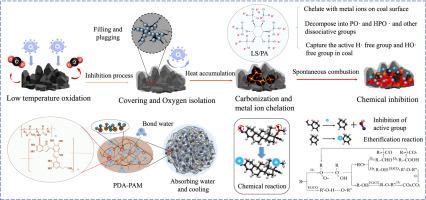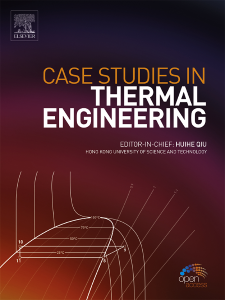Preparation and mechanism analysis of a nano-reinforced environmentally friendly composite gel for coal spontaneous combustion prevention
IF 6.4
2区 工程技术
Q1 THERMODYNAMICS
引用次数: 0
Abstract
Coal spontaneous combustion (CSC) has consistently been a serious safety and environmental concern in the coal industry. A nano-reinforced environmentally friendly composite gel was prepared in this study for air-leakage plugging and CSC prevention. Polyacrylamide, polydopamine, sodium lignosulfonate, phytic acid, epigallocatechin gallate and carbon nanofibers were used as raw materials. The chemical composition, crystallization and morphological structure of the novel gel were characterized. The crosslinked gel of polyacrylamide and polydopamine play a role in moisturizing and encapsulation. The expanded gel formed a carbon layer, effectively isolating the coal surface from the air. The composite gel delayed the second stage of CSC by approximately 20 %. The average heat release during the combustion stage was reduced from 8910 J/g to 7027 J/g, representing a reduction of approximately 26.8 %. The absorption intensity of the typical combustion gas products, CO2 and CO, significantly decreased, and the rising trend was slow below 430 °C. The ultimate pressure of the air leakage plugging was 1.27 kPa. Through analyzing the inhibition and plugging mechanisms of a composite gel, this study provides a more efficient and sustainable solution for inhibiting CSC in goaf, which can enhance production safety, reduce environmental pollution, and minimize losses.

用于防止煤炭自燃的纳米增强型环保复合凝胶的制备及其机理分析
煤炭自燃(CSC)一直是煤炭行业严重的安全和环境问题。本研究制备了一种纳米增强型环保复合凝胶,用于堵塞漏风和防止煤炭自燃。以聚丙烯酰胺、聚多巴胺、木质素磺酸钠、植酸、表没食子儿茶素没食子酸酯和纳米碳纤维为原料。对新型凝胶的化学成分、结晶和形态结构进行了表征。聚丙烯酰胺和聚多巴胺交联凝胶起到了保湿和包裹的作用。膨胀后的凝胶形成了碳层,有效地将煤表面与空气隔离。复合凝胶将 CSC 的第二阶段延迟了约 20%。燃烧阶段的平均放热量从 8910 焦耳/克降至 7027 焦耳/克,降幅约为 26.8%。典型燃烧气体产物 CO2 和 CO 的吸收强度明显降低,在 430 °C 以下上升趋势缓慢。漏气堵塞的极限压力为 1.27 kPa。本研究通过分析复合凝胶的抑制和堵塞机理,为抑制棉籽油中的 CSC 提供了一种更高效、更可持续的解决方案,可提高生产安全性、减少环境污染并最大限度地降低损失。
本文章由计算机程序翻译,如有差异,请以英文原文为准。
求助全文
约1分钟内获得全文
求助全文
来源期刊

Case Studies in Thermal Engineering
Chemical Engineering-Fluid Flow and Transfer Processes
CiteScore
8.60
自引率
11.80%
发文量
812
审稿时长
76 days
期刊介绍:
Case Studies in Thermal Engineering provides a forum for the rapid publication of short, structured Case Studies in Thermal Engineering and related Short Communications. It provides an essential compendium of case studies for researchers and practitioners in the field of thermal engineering and others who are interested in aspects of thermal engineering cases that could affect other engineering processes. The journal not only publishes new and novel case studies, but also provides a forum for the publication of high quality descriptions of classic thermal engineering problems. The scope of the journal includes case studies of thermal engineering problems in components, devices and systems using existing experimental and numerical techniques in the areas of mechanical, aerospace, chemical, medical, thermal management for electronics, heat exchangers, regeneration, solar thermal energy, thermal storage, building energy conservation, and power generation. Case studies of thermal problems in other areas will also be considered.
 求助内容:
求助内容: 应助结果提醒方式:
应助结果提醒方式:


